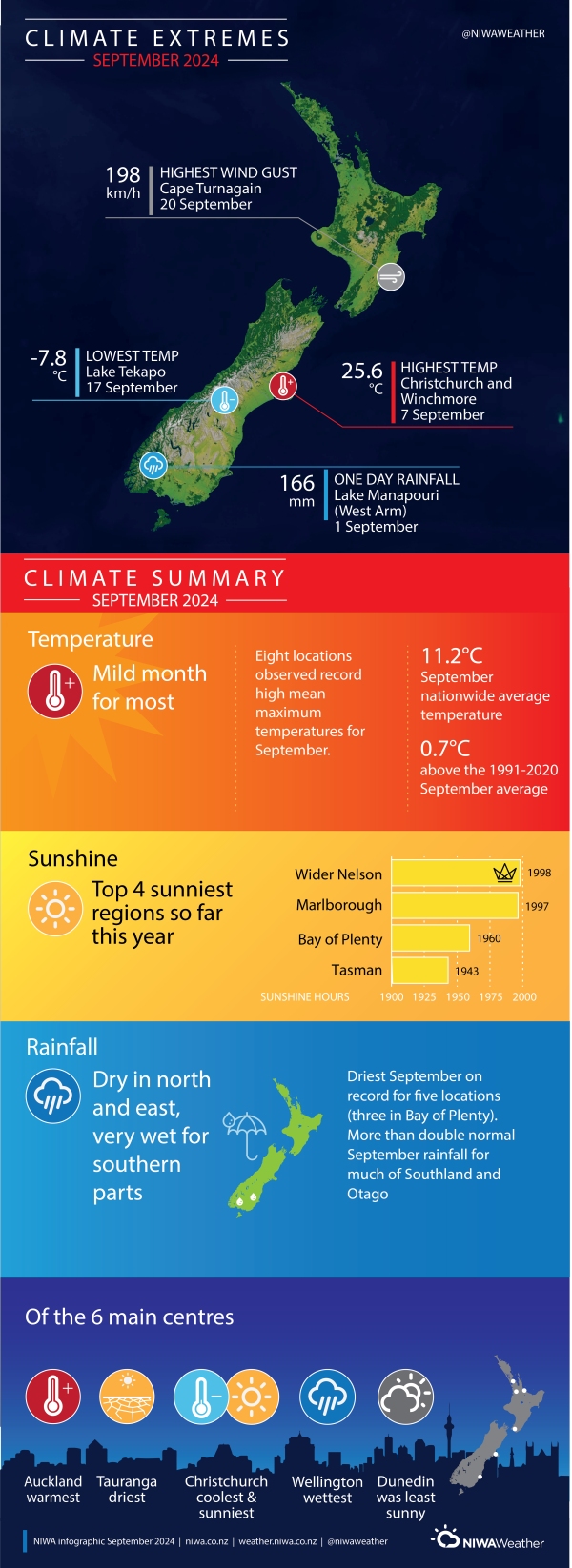Overview
| Temperature | Temperatures were above average (0.51°C to 1.20°C above average) or well above average (>1.20°C above average) in parts of Northland, Auckland, Waikato, Bay of Plenty, Gisborne, Hawke’s Bay, Taranaki, Whanganui, Tararua District, Wellington, Marlborough, much of Canterbury, and eastern Otago. Temperatures were below average (0.51°C to 1.20°C below average) for parts of Fiordland and western Southland. |
| Rainfall | Rainfall was below normal (50-79% of normal) or well below normal (<50% of normal) in northern, eastern and central parts of the North Island, Tasman, Nelson, western Marlborough, and northern and central parts of Canterbury. Rainfall was above normal (120-149% of normal) or well above normal (>149% of normal) for the lower half of the South Island, the West Coast, parts of Wellington, and Manawatū-Whanganui. |
| Soil Moisture | At the end of the month, soil moisture levels were higher than normal for the time of year in eastern and inland parts of Otago and South Canterbury, and lower than normal for parts of Bay of Plenty and Hawke’s Bay. Soil moisture levels were typically near normal for most remaining parts of New Zealand. |
September 2024 was characterised by lower than normal mean sea level pressure over and to the south of the South Island, with higher than normal pressures over the central and northern Tasman Sea. This produced more westerly airflows than normal over most of Aotearoa New Zealand, with more southwesterly airflows over the northern North Island. These westerlies and the associated foehn effect contributed to a relatively warm and dry month for northern and eastern parts of the North and South Islands. However, the westerlies were also accompanied by regular fronts, which delivered abundant precipitation for southern and western parts of the South Island, including the hydro lake catchments. As a result, hydro lake levels increased considerably during September. This alleviated concerns over the low lake levels experienced during the prior winter season.
Temperatures were above average (0.51°C to 1.20°C above average) or well above average (>1.20°C above average) for much of Northland, Auckland, northern Waikato, western Bay of Plenty, Gisborne, Hawke’s Bay, southern and inland Taranaki, Whanganui, Tararua District, Kāpiti Coast, Wellington, Marlborough, most of Canterbury, and eastern Otago. In contrast, temperatures were below average (0.51°C to 1.20°C below average) for parts of Fiordland and western Southland. Temperatures were generally near average (±0.50°C of average) for remaining parts of the country. The nationwide average temperature in September 2024 was 11.2°C. This was 0.7°C above the 1991-2020 September average, making it New Zealand’s 9th-warmest September since NIWA’s seven station temperature series began in 1909.
Rainfall was below normal (50-79% of normal) or well below normal (<50% of normal) in Northland, Auckland, Waikato, Bay of Plenty, Gisborne, Hawke’s Bay, the Central Plateau, Tasman, Nelson, western Marlborough, and northern and eastern parts of Canterbury north of Ashburton. In contrast, rainfall was above normal (120-149% of normal) or well above normal (>149% of normal) for Southland, Otago, Canterbury south of Ashburton, the West Coast, southern Wellington, and parts of Manawatū-Whanganui. Rainfall was near normal (80-119% of normal) for most of Taranaki, Whanganui, and Wairarapa.
Further Highlights:
- The highest September temperature was 25.6°C, observed at Christchurch and Winchmore on 7 September.
- The lowest September temperature was -7.8°C, observed at Lake Tekapo on 17 September.
- The highest 1-day rainfall was 166 mm, recorded at Lake Manapouri (West Arm) on 1 September.
- The highest wind gust was 198 km/h, observed at Cape Turnagain on 20 September.
- Of the six main centres in September 2024, Auckland was the warmest, Tauranga was the driest, Christchurch was the coolest and sunniest, Wellington was the wettest, and Dunedin was the least sunny.
- Of the available, regularly reporting sunshine observation sites, the sunniest four regions in 2024 so far are wider Nelson (1998 hours), Marlborough (1997 hours), Bay of Plenty (1960 hours), and Tasman (1943 hours).


